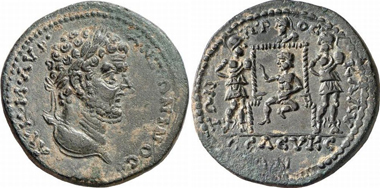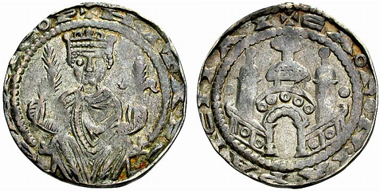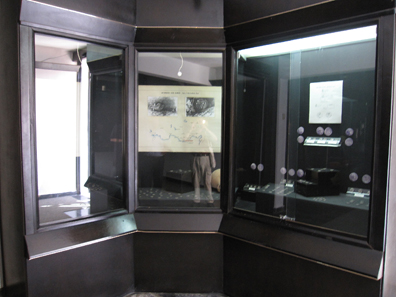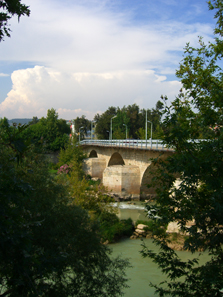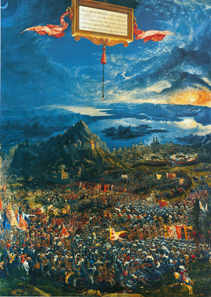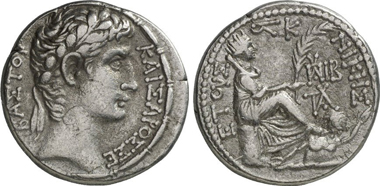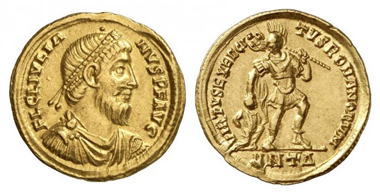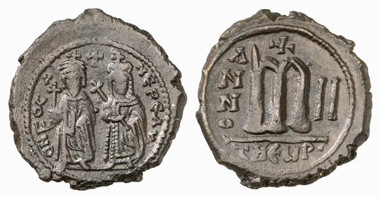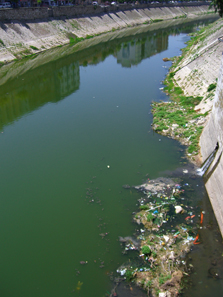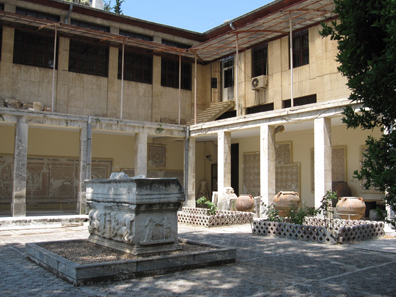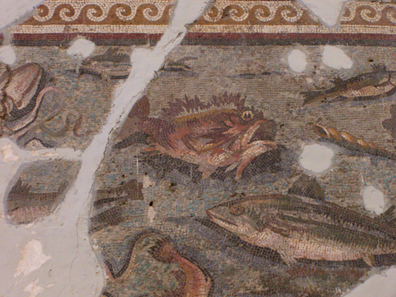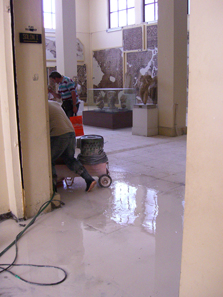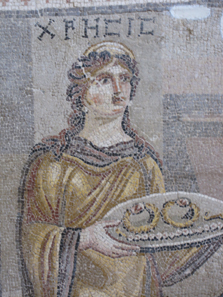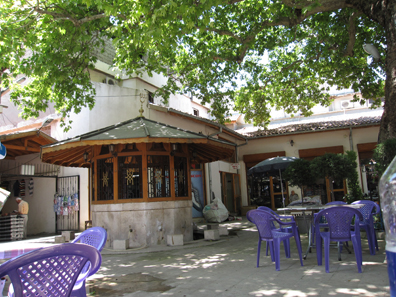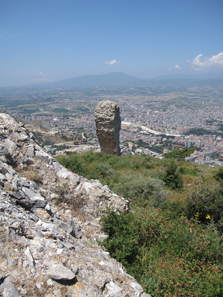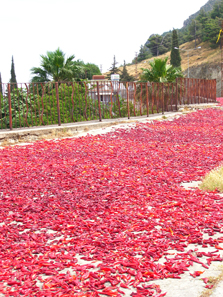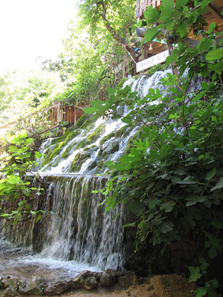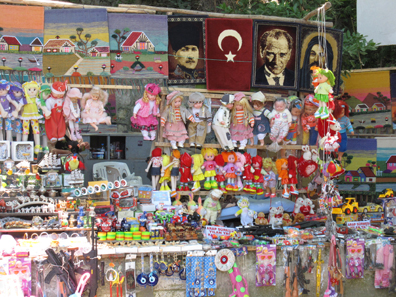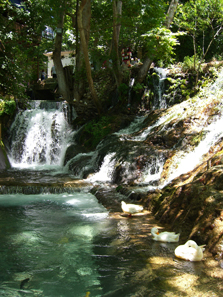by Ursula Kampmann
February 2, 2012 – Silifke, ancient Seleucia on the Calycadnus, is a small provincial town in the middle of nowhere nearby which once Frederick Barbarossa drowned. Follow us on our way to the ancient metropolis Antioch and into the marvellous grove of Daphne, that even today is in the modern Antiochenes’ favour as an important area for recreation.
June 14, 2009 – Silifke
On Sunday we moved on again a bit. We had decided in favour of Silifke. Because I had learned that this was a marvellous small town at Göksu River (= beautiful water) with many green places, not overcrowded and, finally this was ancient Seleucia on the Calycadnus.
Seleucia. Caracalla. Rv. Infant Dionysos enthroned, three corybants dancing around him. SNG Levante 748. From Gorny & Mosch 159 (2007), 306.
Seleucus I founded Seleucia on the Calycadnus transferring to that purpose the inhabitants of Holmoi, a city not far away in the west of Seleuceia. The idea was to establish a military base against the tribes of the Taurus Mountains. But due to its position which was a crucial one in terms of transport, the town became an important commercial hub.
Seleucia. Gordianus III. Rv. Emperor in military habit crowns Tyche of Seleucia. SNG Levante Suppl. 203. From Gorny & Mosch 160 (2007), 2001.
According to its monetary issues Seleucia was one of the major towns in “rugged Cilicia”, but information from literary sources of the Roman Empire is pretty meagre. We do know, though, that the town owned the status of “civitas libera”. Its most prominent citizen was Xenarchus, teacher of the famous geographer Strabo of Amaseia (64 / 63 BC-24 AD).
Frederick I, 1152-1190. Penny. Av. Sitting king with palm leaf and lily. Rv. Wall with three towers. Unpublished. From the Barbarossa hoard. From Münzen und Medaillen Deutschland 28 (2008), 669.
From the middle ages we have more information available. In the seventh century Seleucia was strengthened as Byzantine fortress against Islam. In 1198 at the beginning of the first crusade the castle was lost to the Francs, even though the Byzantine army was able to regain it soon after. Similarly it was hotly fought over during the conflict between Byzantines and Armenians. The whole world came to hear about Calycadnus – or Saleph, as it was called then – when Barbarossa drowned in just that river on 10 June 1190!
And it was exactly that reason why we desired to see that city more closely!
We caught a bus to Silifke. But it did not seem to be an express bus. The bus stopped at each bush behind which someone stood making a signal with his hand. There is nearly no Turk who bothers to go to the bus station. Rather you put yourself on the roadside, wave your hand and you are welcome. This might be quite a comfortable way, but it slows down the drive enormously. Even though this procedure works pretty routinely. The passenger has put his luggage on the roadside, a boy takes it up while the passenger gets into the vehicle. As soon as the luggage box has been closed the driver departs. The boy has to jump into the bus while it accelerates.
It took us just over three hours for 144 kilometres – but it was a splendid journey throughout the rugged Cilicia. Along the coast the mountain road goes over abrupt slopes, wildly romantic valleys, lonely castles.
At a certain point we suddenly had arrived at Silifke. We understood it when the boy asked us to step off the bus. I dared to mention “otogar” (bus station), but nothing. They pulled us out with our luggage. There we stood, in the middle of nowhere looking at each other quite helplessly.
Saint Thecla between two beasts. From auction Gorny & Mosch 156 (2007), 2522.
I had checked beforehand which hotel might fit us and had settled for the Ayathekla. According to the tradition Saint Thecla was saved by a miracle from execution in the flames or by wild beasts; later she ended her live peacefully in a cave near by Silifke marked by a sanctuary until now. A name worthy of a lodging in Silifke, so I thought. Well, the hotel was cheap and the room seemed alright. Two rooms, an operating air con, well, everything deteriorated, the shower a hose and a hole in the floor, but we were in the province. What else to do? Going on searching? No, we took the room and only then I noticed that there was not even a toilet seat. That was enough! I’ve had it! If someone had offered me to return home in that instant, I would have departed immediately. I have had enough of that country where nothing was as it was at home, where allegedly thousands of fantastic sites exist, but where you did never get to because no bus took you there, and where my language capacities were not sufficient to tell the people where I whished to go. I simply sat there weeping and whishing to get away!
Looking into the display cases containing the treasure of Meydancik Kalesi. Photo: KW. – Sorry for the poor quality, but the light was more than difficult!
Instead of returning home we went to the museum. And again it was one of those museums where they see tourists once in a couple of weeks. The museum attendant personally gave us a welcome shaking hands with us. Exclusively for us the light was turned on. At least the famous treasure of Meydancik Kalesi was exposed there, a coin hoard comprising around 5,000 pieces. Most of them were drachms and tetradrachms of Alexander but it contained at least equally many coins of Ptolemy. After all the Ptolemaic dynasty did not only rule nearby Cyprus but as well great parts of the southern coast. Unfortunately the exhibition was, ehm, let’s say it was improvable. The light was more fitting for owls and other nocturnal animals. We could only just recognise some pieces. Although there were really spectacular objects. I even thought to have seen an oktodrachm with the portrait of Ptolemy (but I am not totally certain considering the poor illumination).
Looking at Calycadnus. Photo: UK.
I was not wholly reconciled after the coin hoard, yet. We learned that the place of Barbarossa’s death was too far away to get there by foot. Thus we had no alternative to the tea gardens on the left and right of the nice Calycadnus. Actually they were really pretty, even romantic, but I was mad at Silifke and had no intention of admitting that there was something I liked.
June 15, 2009 – From Silifke to Antakya
On Monday I waked up completely beat. I had slept lousily! My only wish was to get away. In fact I was unfair. Apart from the missing toilet seat everything worked. In contrast to Iskele we even had hot water, the air con cooled down the room for all it was worth, and the biggest surprise was just expecting us downstairs: We went to the reception to find out if there was some tea at least. There was not only tea, the kind man at the reception even frizzled us excellent omelettes! And then we got the usual Turkish breakfast: bread, feta cheese, olives, even honey, jam, gherkins and tomatoes – a feast indeed.
A glance onto the site of ancient Seleucia. Photo: UK.
The next nice surprise expected us at the bank. Because we had slept so badly, we arrived much too soon. The evening before we had spied out which bank opened first. One opened at 8.30. In front of that one we stood nearly half an hour too early. But what happened? The clerk saw us and sent the security officer to let us in. Silifke, thus, gained quite a lot of points!
At the bus station, however, we learned that the next bus that went directly to Antakya was to leave only at 1.30 PM. That meant, alas, nearly four and a half hours to wait. We made ourselves comfortable and waited. At 1.30 there we stood – but there was no bus. So we went to the desk because the day before they had pulled us out of the bus nearby the bus station! Who knew if the bus maybe did not come to the bus station but stopped only at some corner passing by without letting us in? Kurt informed himself. No, they said, the bus was to arrive, only delayed by five minutes. Half an hour later I went there to ask. At least these people showed some constancy: unfortunately five more minutes, they said, but then the bus would have arrived. Indeed he arrived – a fact we had started to doubt vividly. But he came delayed by nearly a whole hour.
In return the bus did not stop during its journey. At the bus station we had not eaten anything because the busses usually pause at nice service areas. That time instead we had just three short comfort stops in a nearly seven hour journey.
The track was very varied. In parts the country side is full of buildings. Every Turk seems to dream of a flat on the seaside – while the realisation of this national dream became an authentic nightmare. There is something like an archetype of a residential building, only the number of floors is different: It is quadrangular and has four flats per floor with a balcony on the corner. Everything is made of cement and candy coloured. These residential buildings extend in lines into the hinterland. And the poor beach! Over and over again we had to recognise that the waste management in Turkey is still fledgling. The leavings of the abundant picnics – nowadays that means indispensably bags of chips, many plastic bottles and other fast food stuff – simply remain there and will be carried away by the wind into the landscape. Corresponding to that is the beaches’ appearance.
But as soon as we left the coast and entered the hinterland the environment was wildly romantic. Endless fields of sunflowers, rice and orange plantations bordered the roads. We drove through a hilly country arriving by and by to the mountains, to the Cilician Gates that were a military locking bolt to invasion armies through all the times.
Alexander battle by Albrecht Altdorfer. Alte Pinakothek München. Source: Wikipedia.
Hence, we sat there excited with our map, waiting till we saw the place where we thought Alexander fought against Darius in 333. Maybe the place was not that correct, but nevertheless we felt terrific!
We arrived in Antakya. We found a charming hotel situated in an old Turkish dwelling house. We got the room under the roof. It was so clean, there was everything you needed, I only felt bad about the young man who dragged upstairs our heavy suitcases all the many stairs.
June 16, 2009 – Antioch
This morning we woke up recreated. We were in Antioch, one of the most prominent cities of the Roman Empire. Here was the gathering place for the army when the Romans marched against the Parthians one more time again! Here they struck wonderful coins. Here everything had to be full of history and ruins, I thought.
Antiochus VIII Epiphanes, 125-96. Tetradrachm, Antioch. Rv. Zeus Nikephoros. From Gorny & Mosch 200 (2011), 2015.
After the battle of Ipsus, the culmination of the fight between the Diadochs in 300, Seleucus I founded the city of Antioch – modern Antakya – in memory of his father Antiochus. Already under the Seleucids the city flourished thanks to its favourable geographic position. Antiochus I chose Antioch to be his western capital. It was only when the Pergamenian Attalids replaced the Seleucids as dominators of Asia Minor that the importance of this residence was declining. “The Golden” Antioch was called, probably because of its splendour but also because it was resplendent anew again and again. Due to the many earthquakes of which the first is attested in 148 BC the city was periodically built afresh.
Augustus. Tetradrachm, 5 BC. Rv. Tyche of Antioch, beneath her feet Orontes. From Gorny & Mosch 200 (2011), 2250.
Immediately after their conquest of the east the Romans understood Antioch’s strategic importance. They made it their military, administrative and political base. Probably in the 2nd century AD Antioch was on its peak. We estimate its inhabitants in this period between 400,000 and 600,000. Thus, Antioch was the third largest city of the ancient world.
Philipp II. Antoninianus, Antioch. Rv. Philipp sacrificing. RIC 236. From Gorny & Mosch 200 (2011), 2750.
Frequently Antioch became official imperial mint when it was necessary to issue money during a campaign.
And it became a centre of the early Christians. Here, so the saying goes, the followers of the apostles Peter and Paul were called Christians for the very first time.
Julian the Apostate. Solidus, Antioch. RIC 202. From Künker 174 (2010), 1039.
No surprise that the Antiochenes did not get along well with Julian who called himself proudly “the Apostate”. When he visited the city during his campaign against the Persians, Julian criticised that the old cults more or less had sunk into oblivion. In Antioch they paid it back with mockery and an obstructive attitude; this made the emperor write the satire “Beard Hater”.
Phocas and Leontia. Follis, 603/4, Antioch (= Theopolis). Sear 671. From Künker 153 (2009), 9127.
In 526 a powerful earthquake destroyed Antioch. Later Justinian restored many public buildings and renamed the city Theopolis. But only twelve years later Sasanid Khosrau I conquered Antioch. Even though the Byzantine rule was reestablished for a short while, the Arabs occupied the city in 637. It was Antioch’s very position of frontier that made it a bone of contention between the Islamic Realms and the Byzantine Empire, which was pinched by the crusaders in 1098.
And from now on the affair gets really tricky. Hence, let’s leave it at that short overview of Antioch’s history in antiquity.
Modern Orontes. Quite a filthy sewer. Photo: UK.
At first we went to the famous museum of mosaics in Antakya. To get there we had to cross Orontes River. Once in ancient times Orontes was one of the most noted rivers of the Roman Empire, today it is a deplorable rill of a green colour that reminds of chemical processes, and full of filth. One feels like composing the dirge of a congested river god. Thinking of how often I saw Orontes pictured as a young man swimming under her feet. I think he would not even disgustedly dip his toe into the water.
Inner court of the museum of Antioch. Photo: KW.
Even the museum of Antioch has had its days. The building looks as if it were to crumble before the next earthquake, yet. Labels are a phenomenon they still have to import to Antakya. And when I was in Germany I thought that I might buy a lot of intriguing guide books there! They had not even invented postcards, yet!
Depiction of fishes on a mosaic. Photo: UK.
Naturally, the objects in exposition were terrific, even though we could see only a fraction of the whole. Because there was work in progress in the museum. What they were actually doing was not very clear to us. They just had closed half of the complete museum.
Construction works in the museum of Antakya. Photo UK.
A polishing machine screeched flooding the halls, a dust cloud raised as if a jeep was bombing down a desert track at 45 mph. The mosaics just gazed at the scenery and kept their thoughts to themselves.
Depiction of Chryseis. Photo: KW.
Of course the mosaics were splendid, although we were not able to see more than around a third of them due to the construction works. Some of them were very delicate showing naturalistic fishes, others were rougher, but all of them with incredulous colours. Thank goodness the ancient people were so common-sense to write onto the mosaics what they show, otherwise the interpretation of some of the pictures would have been pretty awkward.
Shade and calmness in the bazaar. Photo: KW.
After the museum we needed some water. Thus, we went to the next supermarket. Thankfully we did not find any, but instead we found an authentic covered bazaar. For the first time during this holiday Antakya gives me the feeling of being really in a Turkish city. The bazaar was marvellous, everything farrago, shoes, dresses, soap, foods, spices, gold, money changer, small boys with tea trays, girls wearing sleeveless tops and miniskirts next to Turkish women heavily veiled with headscarf and long cloak. There were not many tourists around, on the contrary. The small children chased us considering us real funny and picturesque. Others tried to beg but were called away by some grown-up. You don’t get the impression that many tourists come to Antakya!
June 17, 2009 – Antioch
This morning we woke up because the earth trembled. Really. Our bed was shaking. Before my eyes I saw myself buried under ruins and praised my anticipation that made me choose a room on the last floor. While we were feeling like survivors of an immense catastrophe, life on the street went on as usual. It seems that this kind of earthquake is absolutely normal here. At least no one pretended that something special had happened.
View over the city from the fortifications. Photo: KW.
Since the Hellenism Antioch was a city with a strong fortification. The real urban area was constructed on the other side of Orontes river on a crest and secured by an impressive wall. On top of the big ashlar blocks of the Hellenistic building the Romans put their bricks and the Byzantines their quarry stones. Later Seljuks and crusaders repaired the walls for centuries adding their towers, thus, the wall stood until modern times. Today there are only deplorable ruins on the crests. According to Kurt we had to walk up.
From a certain height upward they used the streets to desiccate pepper. Photo: UK.
Initially we walked uphill on paved streets. Then countless stairs substituted them. Of course people watched us. It seems that really not many tourists happen to get lost into this area. The stairs led us to a simple gravel walk. We arrived higher and higher, at a certain point we stood above the world when there was no way to proceed further. Well, there was still a goat track. Kurt said, we would make it up there and on the other side there would certainly be some more comfortable way down. To cut a long story short. We got up (even though I lamented quite a bit) and there was no comfortable way down. Thus we had to creep over slippery, steep goat tracks in the middle of nowhere, our legs were pierced and I was on the ropes when we arrived down. (The only thing I had seen of the old fortification was a pretty ruinous rest of a former tower.)
In the evening we went into the town. Boys stood at every corner selling chicklets. Not only chicklets, the poor creatures were coloured in pink, green, and blue. You simply had to pity them. What the Turks do with them? No idea.
June 18, 2009 – Daphne’s grove
Today we drove to Harbiye to the ancient grove of Daphne.
Restaurant in Daphne’s grove. Photo: KW.
In this place once Mark Antony and Cleopatra whispered sweet nothing to each other (if they did so, but maybe the whole affair was a politically motivated marriage, anyhow we do not want to start that debate again …). Here it was where Lucius Verus on the eve of his war against the Parthians amused himself with a famous hetaera and shaved off his beard of philosopher after a boozy feast. The story goes that in the following days Lucius Verus had to hide until his impressive beard had grown again to some degree – at least I remember something of that kind.
Today Daphne’s grove is still destination of the Antiochenes’ trips. Thank goodness they seem to go there rather in the evening or in the week-end. Hence we enjoyed nearly alone this cosy grove with its laurels and sparkling waters.
All the kitsch of the world. Photo: KW.
We took a dolmus to Harbiye. And yet, at the terminal stop there were souvenir shops with all the kitsch of the world. Funny, after nearly two weeks in Turkey I had never run the risk of buying some souvenir. Firstly there is hardly something suitable, secondly a good argument against any kind of mispurchase is a heavy, overloaded bag.
Technically speaking Daphne Valley is nothing else than different restaurants all of them idyllically situated nearby waterfalls, ponds or pools with fishes and ducks, and they all offer various kinds of meze and kebab. The temperature alone is part of the area’s attraction, in no other place in Turkey it is so cool. And then the continuous ripple of water – one understands why the Antiochenes believed a god to operate here.
You bear the high temperatures much better with your feet in the water. Photo: UK.
We ate in a small restaurant beside a little cascade that poured into a pool in which around hundred trouts were swimming and a small flock of ducks. The tables were put on a platform that was built into the water; thus behind my back a duck sat in her nest breeding eggs. We did not get far with our limited knowledge of Turkish. The host decided that we ordered an assortment of all his appetisers – around ten small plates with everything you can imagine. Kurt decided that the host had not understood right, thus put aside vigorously half of the plates, but the host rearranged them again on the table.
View from our table. Photo: UK.
At this point the Turkish-Oriental and the German-Swiss world view met: We are used to eat everything put on the table. A good restaurant is characterised by portions of a dimension that one can finish having eaten one’s fill – but without having overeaten. Here, on the other hand it is abundance what counts: As much food as possible has to be on the table. I saw a couple in front of which they put over 15 plates. Later most of it the waiters took away. Hence, lavishness is the key and a paunch raises the reputation. How in the world a Turk would have understood, if we explained to him that we will never eat everything of this food. He does not pretend that we do, we are only invited to enjoy the opulence!
And now that’s it for today. Follow us again when we continue our journey into the hinterland. We will visit the magic mosaics of the city of Zeugma in the museum of Antep and then we will drive to Urfa, the ancient Edessa.
You can read all other parts of this diary here.




